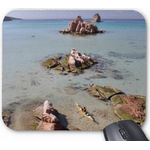Our original plan was to cross the Andes through the Paso Jama, in the province of Jujuy, get to San Pedro de Atacama in Chile and from there cross into Bolivia through the Paso Hito Cajón. In the Sud Lípez, the Southwest corner of Bolivia, is where the Green, White and Red lagoons and other unique natural attractions are located, in addition to the very famous Salar de Uyuni, a must-ride for any self-respecting cyclist (or so they say). Then we wanted to continue on to Potosi and Sucre. But the polar cold front made us rethink the trip. Both Paso Jama and Hito Cajón are closed to traffic due to snow accumulation. In Paso Ollagüe, a little farther north on the border between Chile and Bolivia, 6 feet of snow has fallen, the heaviest in the last 10 years. We have not come to fight the elements, and after the cold on tour from Humahuaca to Calilegua, riding in the Bolivian highlands doesn´t seem too smart. In fact, a couple of weeks later, in Sucre, we read in a newspaper an article about the snow in the North and South Lípez titled “Huge snowfall”. It seems we have escaped from a good one: up to 3 feet of snow, -8 F, food supply issues for livestock and rescue of a group of tourists...
Our new plan is to return to Salta and from there fly to Sucre (via Santa Cruz de la Sierra). From Sucre get the ferrobus to Potosí, and start riding again from there.
Stage index:
From July 12 to 14 and July 28 to August 1, 2011: Sucre
July 15, 2011: From Sucre to Potosi by ferrobus
From July 16 to 19, 2011 : Potosí
From July 12 to 14 and July 28 to August 1, 2011: Sucre
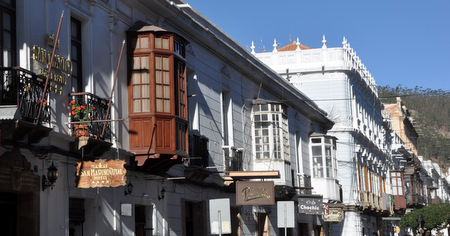 Sucre, the white city, is a city with whitewashed walls, double wooden doors, robust and worn out by the passage of time, iron work on balconies and windows, and cloistered patios. Colonial-style churches and monasteries from the sixteenth century, cobblestone streets and plazas and gardens where plants and flowers are arranged in clear-cut geometric shapes. Sucre is a bright city, quiet and cozy.
Sucre, the white city, is a city with whitewashed walls, double wooden doors, robust and worn out by the passage of time, iron work on balconies and windows, and cloistered patios. Colonial-style churches and monasteries from the sixteenth century, cobblestone streets and plazas and gardens where plants and flowers are arranged in clear-cut geometric shapes. Sucre is a bright city, quiet and cozy.
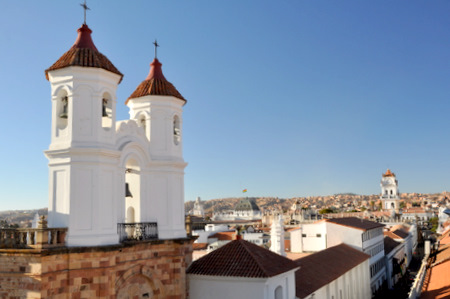 The colors of the Andean dresses dot the streets. Women and men dressed in the traditional Quechua style, with colored skirts and bundles lying on their backs, loaded with products to be sold or children with dark skin, round face and big eyes. Women and men dressed in Western-style suits and jackets, perfectly clean, without wrinkles and the ironing line marked on the pants, well groomed and perfumed, with accelerated pace and laptop bag. Light skin Mennonites with traditional clothing and cowboy hat or scarf covering the hair. All, indigenous people, European descendants and Mennonites mix on the sidewalks peacefully. The tourists are he ones out of the picture...
The colors of the Andean dresses dot the streets. Women and men dressed in the traditional Quechua style, with colored skirts and bundles lying on their backs, loaded with products to be sold or children with dark skin, round face and big eyes. Women and men dressed in Western-style suits and jackets, perfectly clean, without wrinkles and the ironing line marked on the pants, well groomed and perfumed, with accelerated pace and laptop bag. Light skin Mennonites with traditional clothing and cowboy hat or scarf covering the hair. All, indigenous people, European descendants and Mennonites mix on the sidewalks peacefully. The tourists are he ones out of the picture...
The pace of Sucre is more like that of a large village than a city. No crowds, people are friendly and the few lines we see are calm. By European standards, everything is very cheap. Here in the city you can’t see much poverty, but a few homeless. In rural areas, where the majority of the Quechua, Aymara, Guaraní, etc communities live, poverty is much more common. In fact, in Bolivia, the poverty rate is around 70%.
 Grocery markets are like farmer´s markets, but with less hygiene. The meat is on the marble countertops or hung from a bar. The farmers selling fruit and vegetable are sitting on the floor and offer their products displayed on top of the bundle fabric. The central market is very organized. Each product type has a designated area: bread, eggs, meat, poultry, fruit, bananas (yes, bananas have their own space)... One difference is that here, in the market, there are dining stalls, where they prepare soups, meat sauce or sausage in large pots and pans. The dishes are served quickly and you share table with strangers. Before you realize, you've finished eating.
Grocery markets are like farmer´s markets, but with less hygiene. The meat is on the marble countertops or hung from a bar. The farmers selling fruit and vegetable are sitting on the floor and offer their products displayed on top of the bundle fabric. The central market is very organized. Each product type has a designated area: bread, eggs, meat, poultry, fruit, bananas (yes, bananas have their own space)... One difference is that here, in the market, there are dining stalls, where they prepare soups, meat sauce or sausage in large pots and pans. The dishes are served quickly and you share table with strangers. Before you realize, you've finished eating.
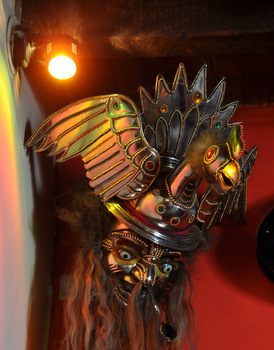 Wandering around Sucre is fantastic: the main plaza, the Bolivar park, La Recoleta... In every corner there are details that catch your attention: wooden balconies, business signs, friezes and colonial decorations... One could spend days and days visiting religious buildings and museums. We only visit a few. The cathedral and its museum are a must-see. The rear of the altar has a very interesting set of carved wooden chairs and lectern. The museum has a collection of crowns, reliquaries and other religious items in silver, gold and precious stones. We also visit the Church of La Merced, where we climb to the bell tower to enjoy a 360 degree view of the city. From the top you can see the cathedral, the town council and countless other churches. Many of the houses have courtyards with stone walls or painted in bright colors. Usually in the center there is a fountain or a well and the sides are adorned with plants and flowers. They are perfect for a coffee or a cake isolated from the bustle of the streets. The Museum of Ethnography and History is very interesting. It includes a collection of masks from around the country, from the super-ornate and extravagant carnival of Oruro, to the most simple, just logs cut and painted from the Amazon Basin.
Wandering around Sucre is fantastic: the main plaza, the Bolivar park, La Recoleta... In every corner there are details that catch your attention: wooden balconies, business signs, friezes and colonial decorations... One could spend days and days visiting religious buildings and museums. We only visit a few. The cathedral and its museum are a must-see. The rear of the altar has a very interesting set of carved wooden chairs and lectern. The museum has a collection of crowns, reliquaries and other religious items in silver, gold and precious stones. We also visit the Church of La Merced, where we climb to the bell tower to enjoy a 360 degree view of the city. From the top you can see the cathedral, the town council and countless other churches. Many of the houses have courtyards with stone walls or painted in bright colors. Usually in the center there is a fountain or a well and the sides are adorned with plants and flowers. They are perfect for a coffee or a cake isolated from the bustle of the streets. The Museum of Ethnography and History is very interesting. It includes a collection of masks from around the country, from the super-ornate and extravagant carnival of Oruro, to the most simple, just logs cut and painted from the Amazon Basin.
Go to top
July 15, 2011: From Sucre to Potosi by ferrobus
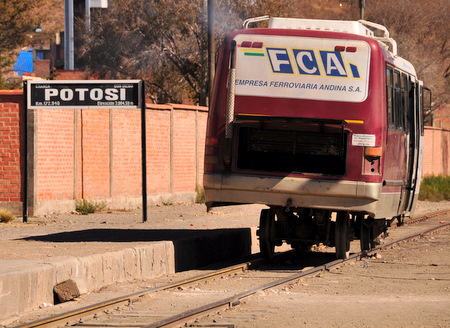 After six hours of tremors on a railways not very straight and without going to the bathroom, we arrive in Potosí. Well, Judit had to run down to empty the bladder without much parapet. Close to her, a local only had to crouch, fluff her skirt a little and let it go as if nothing happened. The bikes, still in the boxes where they flew from Argentina, have been on the "grill" on the roof of the ferrobus, under other boxes and packages from other travelers. Obviously, we are the only tourists on the ferrobus. The other passengers are farmers going to the city or returning to their village. Most are women with wrinkled dark skin, scorched by the sun. They all carry colorful bundles and are usually accompanied by one or two children. Most conversations are in Quechua, the language that has survived since the Inca Empire. Unfortunately we do not understand a word. In some of the "stations" there are more passengers that space in the ferrobus, and some have to stay. This makes us feel a bit guilty, because this transport is a kind of social service for the inhabitants of the villages through which it passes, where it’s difficult or impossible to reach by car. The aisle is already full. At each stop, the driver's assistant urges passengers to move to the back to make room for more people. One of the grandmothers that comes up even brings her own mini stool to sit comfortably in the aisle. Once installed, the stool is invisible below her many skirts.
After six hours of tremors on a railways not very straight and without going to the bathroom, we arrive in Potosí. Well, Judit had to run down to empty the bladder without much parapet. Close to her, a local only had to crouch, fluff her skirt a little and let it go as if nothing happened. The bikes, still in the boxes where they flew from Argentina, have been on the "grill" on the roof of the ferrobus, under other boxes and packages from other travelers. Obviously, we are the only tourists on the ferrobus. The other passengers are farmers going to the city or returning to their village. Most are women with wrinkled dark skin, scorched by the sun. They all carry colorful bundles and are usually accompanied by one or two children. Most conversations are in Quechua, the language that has survived since the Inca Empire. Unfortunately we do not understand a word. In some of the "stations" there are more passengers that space in the ferrobus, and some have to stay. This makes us feel a bit guilty, because this transport is a kind of social service for the inhabitants of the villages through which it passes, where it’s difficult or impossible to reach by car. The aisle is already full. At each stop, the driver's assistant urges passengers to move to the back to make room for more people. One of the grandmothers that comes up even brings her own mini stool to sit comfortably in the aisle. Once installed, the stool is invisible below her many skirts.
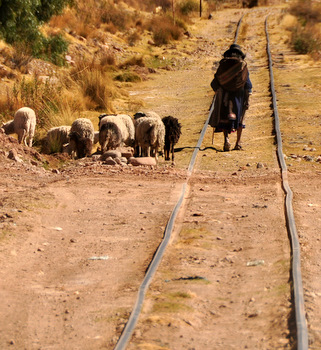 The sound of screeching metal wheels against the tracks does not fit the image of the driver clutching the steering wheel and shifting gears of the ferrobus. Along the way, pigs, chickens, donkeys, cows and goats have been on the verge of suffering a heart attack when they heard the horn to scare them away from the rail tracks. Crossing some of the bridges has been an exercise of faith ... At the station of Potosi, at 13000 feet, a policeman helps us get a taxi. He writes down the driver's name and registration so that we have no problems.
The sound of screeching metal wheels against the tracks does not fit the image of the driver clutching the steering wheel and shifting gears of the ferrobus. Along the way, pigs, chickens, donkeys, cows and goats have been on the verge of suffering a heart attack when they heard the horn to scare them away from the rail tracks. Crossing some of the bridges has been an exercise of faith ... At the station of Potosi, at 13000 feet, a policeman helps us get a taxi. He writes down the driver's name and registration so that we have no problems.
Go to top
From July 16 to 19, 2011: Potosí
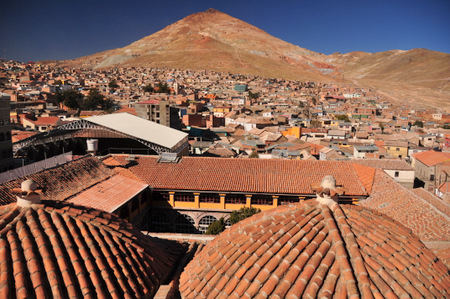 Potosí is eminently a mining city, with the Cerro Rico dominating the skyline. It seems incredible that after more than 400 years of exploitation, extraction is still profitable. There is still some silver, but more zinc and lead, in addition to the touristy development of the mine with guided tours inside. It seems that the miners do not charge for these visits, which are paid by tourists, but they expect some kind of gift, like dynamite, detonators or coca. We did not visit any mines. Instead we watch a documentary about child miners, "The Devil's Miner", in the hostel where we are staying. We don’t like the idea of entering one of the many mines that bore the hill (which changed its morphology due to a collapse), and observe the harsh conditions of miners with school age. The film was very enlightening and sad at the same time... Poverty in many rural areas forces families to move into town and try their luck at mining. The job is a great honor and knowledge and customs are passed on from father to son with great pride. Alcohol and coca are part of the ritual, not only for consumption, but also as offerings to their God of darkness asking him to protect them from accidents in the mine and luck to find precious material. They call it Tío, and represent it physically with a demon-looking statue that is at the entrance of every one mine.
Potosí is eminently a mining city, with the Cerro Rico dominating the skyline. It seems incredible that after more than 400 years of exploitation, extraction is still profitable. There is still some silver, but more zinc and lead, in addition to the touristy development of the mine with guided tours inside. It seems that the miners do not charge for these visits, which are paid by tourists, but they expect some kind of gift, like dynamite, detonators or coca. We did not visit any mines. Instead we watch a documentary about child miners, "The Devil's Miner", in the hostel where we are staying. We don’t like the idea of entering one of the many mines that bore the hill (which changed its morphology due to a collapse), and observe the harsh conditions of miners with school age. The film was very enlightening and sad at the same time... Poverty in many rural areas forces families to move into town and try their luck at mining. The job is a great honor and knowledge and customs are passed on from father to son with great pride. Alcohol and coca are part of the ritual, not only for consumption, but also as offerings to their God of darkness asking him to protect them from accidents in the mine and luck to find precious material. They call it Tío, and represent it physically with a demon-looking statue that is at the entrance of every one mine.
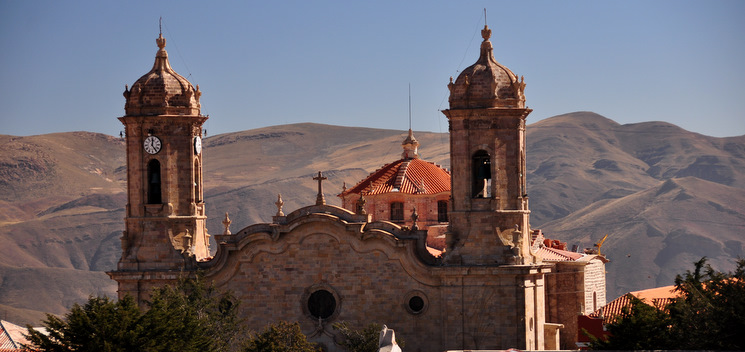
In a hardware store we find Abel, the owner, a Spanish settled here. He also owns an ingenio, as they call here the mineral processing plants. Abel graciously allows us to visit it and the next morning one of his engineers gives us a tour of the various refining processes to convert the ore miners extract to a mineral of a purity between 50 and 75%. Here the conditions are totally different from the mine. The workers wear masks, goggles and helmet and appropriate clothing. It also appears to care about the conservation of the environment and both waste disposal and water recycling are integrated into the refinement process of the ore. We take a sample of lead ore, a small rock with smooth and shiny faces that weighs more than you would say.
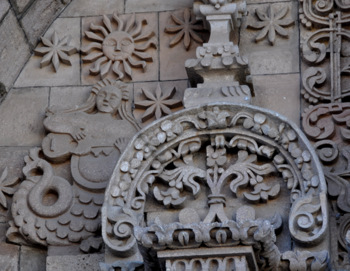 A part of mining, the city has many churches. Some date from the seventeenth century. They are worthwhile not only for the architecture, but for the paintings preserved inside. In particular, some include pictures of the Potosi School painter Melchor Pérez de Holguín. Most notable is the mixture of Christian elements with indigenous ones and the unique vision introduced by local painters of colonial elements in biblical scenes. For example, we notice a painting in which the Roman executioners of Jesus Christ wear uniforms and costumes like the conquistadores. Like this one, many details can be seen both in the extensive collection of paintings of the Convent of San Francisco and La Casa de la Moneda Nacional.
A part of mining, the city has many churches. Some date from the seventeenth century. They are worthwhile not only for the architecture, but for the paintings preserved inside. In particular, some include pictures of the Potosi School painter Melchor Pérez de Holguín. Most notable is the mixture of Christian elements with indigenous ones and the unique vision introduced by local painters of colonial elements in biblical scenes. For example, we notice a painting in which the Roman executioners of Jesus Christ wear uniforms and costumes like the conquistadores. Like this one, many details can be seen both in the extensive collection of paintings of the Convent of San Francisco and La Casa de la Moneda Nacional.
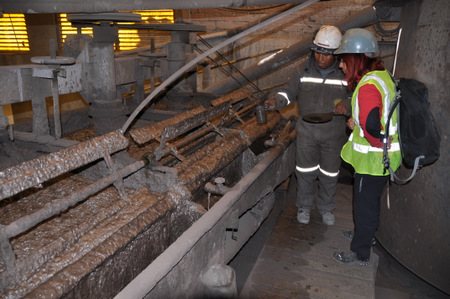 Also recommendable is the visit to the Convent of Santa Teresa, where the daughters of wealthy families around the country struggled to be accepted as nuns (based on handing out valuable gifts to the monastery which are now part of the collection held there) at the age of 15 years, where they remained for life without being able to see (nor be seen) to his family. There are currently a dozen nuns, but the conditions have been relaxed and they may even go out. Interesting tour, but too quick to appreciate the value of the donated gifts.
Also recommendable is the visit to the Convent of Santa Teresa, where the daughters of wealthy families around the country struggled to be accepted as nuns (based on handing out valuable gifts to the monastery which are now part of the collection held there) at the age of 15 years, where they remained for life without being able to see (nor be seen) to his family. There are currently a dozen nuns, but the conditions have been relaxed and they may even go out. Interesting tour, but too quick to appreciate the value of the donated gifts.
Outside of the churches, museums and monasteries, the city moves at a frenetic pace, pedestrians as well as taxis and buses, especially in the vicinity of the markets. We are forced to be part of that pace in our supply for products we need to hit the road in the next days.
Go to top
© 2014 Explore Pangea. All Rights Reserved. Website
Terms
of Use.











